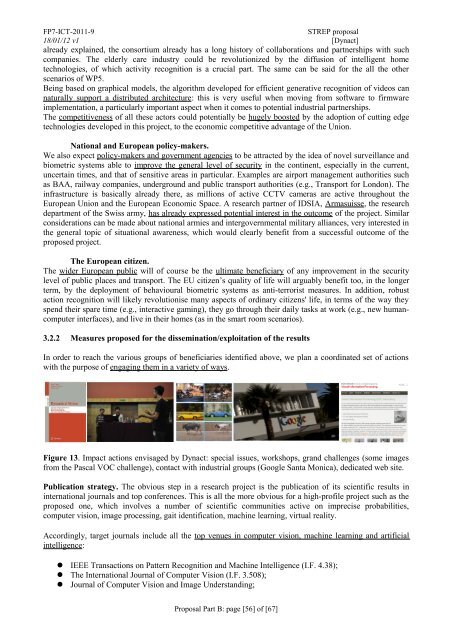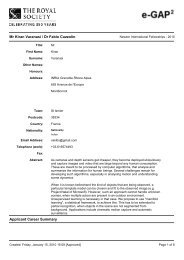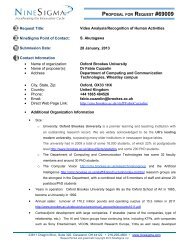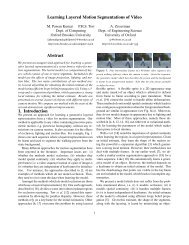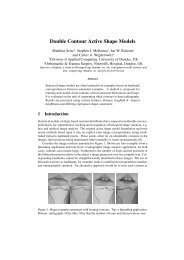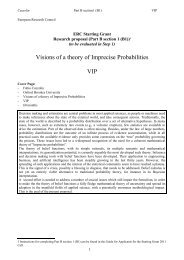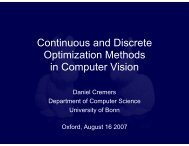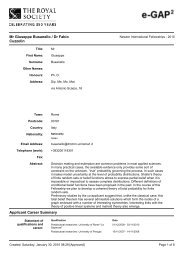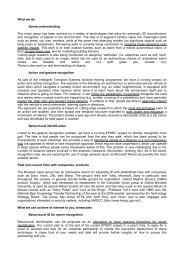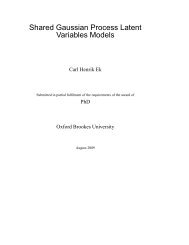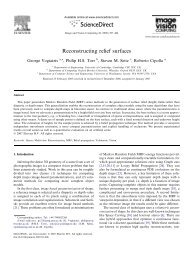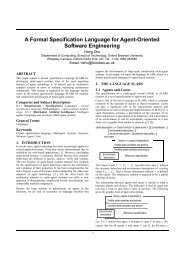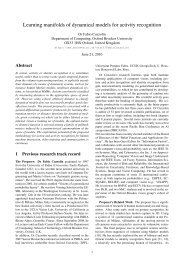Project Proposal (PDF) - Oxford Brookes University
Project Proposal (PDF) - Oxford Brookes University
Project Proposal (PDF) - Oxford Brookes University
You also want an ePaper? Increase the reach of your titles
YUMPU automatically turns print PDFs into web optimized ePapers that Google loves.
FP7-ICT-2011-9 STREP proposal<br />
18/01/12 v1 [Dynact]<br />
already explained, the consortium already has a long history of collaborations and partnerships with such<br />
companies. The elderly care industry could be revolutionized by the diffusion of intelligent home<br />
technologies, of which activity recognition is a crucial part. The same can be said for the all the other<br />
scenarios of WP5.<br />
Being based on graphical models, the algorithm developed for efficient generative recognition of videos can<br />
naturally support a distributed architecture: this is very useful when moving from software to firmware<br />
implementation, a particularly important aspect when it comes to potential industrial partnerships.<br />
The competitiveness of all these actors could potentially be hugely boosted by the adoption of cutting edge<br />
technologies developed in this project, to the economic competitive advantage of the Union.<br />
National and European policy-makers.<br />
We also expect policy-makers and government agencies to be attracted by the idea of novel surveillance and<br />
biometric systems able to improve the general level of security in the continent, especially in the current,<br />
uncertain times, and that of sensitive areas in particular. Examples are airport management authorities such<br />
as BAA, railway companies, underground and public transport authorities (e.g., Transport for London). The<br />
infrastructure is basically already there, as millions of active CCTV cameras are active throughout the<br />
European Union and the European Economic Space. A research partner of IDSIA, Armasuisse, the research<br />
department of the Swiss army, has already expressed potential interest in the outcome of the project. Similar<br />
considerations can be made about national armies and intergovernmental military alliances, very interested in<br />
the general topic of situational awareness, which would clearly benefit from a successful outcome of the<br />
proposed project.<br />
The European citizen.<br />
The wider European public will of course be the ultimate beneficiary of any improvement in the security<br />
level of public places and transport. The EU citizen’s quality of life will arguably benefit too, in the longer<br />
term, by the deployment of behavioural biometric systems as anti-terrorist measures. In addition, robust<br />
action recognition will likely revolutionise many aspects of ordinary citizens' life, in terms of the way they<br />
spend their spare time (e.g., interactive gaming), they go through their daily tasks at work (e.g., new humancomputer<br />
interfaces), and live in their homes (as in the smart room scenarios).<br />
3.2.2 Measures proposed for the dissemination/exploitation of the results<br />
In order to reach the various groups of beneficiaries identified above, we plan a coordinated set of actions<br />
with the purpose of engaging them in a variety of ways.<br />
Figure 13. Impact actions envisaged by Dynact: special issues, workshops, grand challenges (some images<br />
from the Pascal VOC challenge), contact with industrial groups (Google Santa Monica), dedicated web site.<br />
Publication strategy. The obvious step in a research project is the publication of its scientific results in<br />
international journals and top conferences. This is all the more obvious for a high-profile project such as the<br />
proposed one, which involves a number of scientific communities active on imprecise probabilities,<br />
computer vision, image processing, gait identification, machine learning, virtual reality.<br />
Accordingly, target journals include all the top venues in computer vision, machine learning and artificial<br />
intelligence:<br />
IEEE Transactions on Pattern Recognition and Machine Intelligence (I.F. 4.38);<br />
The International Journal of Computer Vision (I.F. 3.508);<br />
Journal of Computer Vision and Image Understanding;<br />
<strong>Proposal</strong> Part B: page [56] of [67]


